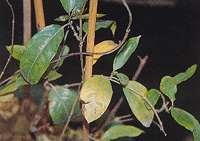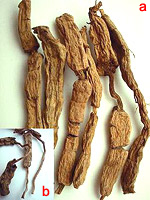|
 |
| Original plant of Radix Morindae Officinalis |
| |
 |
| Dried roots |
|
| Name |
Latin Name: Radix Morindae Officinalis
Common Name: Morinda Root / Medicinal Indian mulberry Root
Scientific Name: Morinda officinalis
Chinese Name: 巴戟天
Pinyin Name: Ba ji tian |
| Top |
|
| Origin |
| The dried root of Morinda officinalis How; family Rubiaceae.[1] |
| Top |
|
| Where Does It Grow? |
| It is mainly distributed in Guangdong, Guangxi and Fujian provinces of China[1-2]. |
| Top |
|
|
| Nature and Taste |
| It is sweet and pungent in taste and slightly warm in nature. It enters kidney and liver meridians[1]. |
| Top |
|
| Identified Active Components/ Major Chemical Constituents[3] |
Identified active ingredients include: Rubiadin, rubiadin-1-methyl-ether, methyl-ether from Radix et Rhizoma Rhei, monotropein, tetraacetylasperuloside, β-sitosterol, palmitic acid, nonadecalkane [4-7] and dimethyl-alkane[8]. Radix Morindae Officinalis also contains monosaccharides, polysaccharides, resin, vitamin C, 11 free amino acids and 17 amino acid hydrolysates[8].
The cortex of Radix Morindae Officinalis (pic.a) contains reducing sugars and glycosides, cardiac glycosides, flavones, triterpenoid steroids, amino acids, organic acids, micro-anthraquinone and metal elements. More abundant microelements include potassium (K), calcium (Ca) and magnesium (Mg). The lead content in the cortex is lower than in the root core (pic.b). Other elements like iron (Fe), manganese (Mn), zinc (Zn) and 16 others are higher in the cortex than in the root core.[10-11]
|
| Top |
|
| Historical Use |
|
Radix Morinda officinalis enters the blood aspect of the kidney meridian, strengthens reproductive functions (which is termed as "strengthening yin" in the text) and benefits essence (jing). It can treat various kinds of impairments caused by overstrain and "disperse" wind and dampness evils attacking the body; because, pungent tastes are good for dispersing functions. It can also treat edema (swelling) in the feet caused by an attack of wind evils and/or dampness evils[3]. |
| Top |
|
| What is It Used for in TCM? |
Radix Morinda officinalis invigorates kidney yang, strengthens tendons and bones and removes wind and dampness evils.[1]
| 1. |
It is used in the treatment of kidney yang deficiency type erectile dysfunction, infertility, menstruation disorders, and cold-type pain in the lower abdomen. |
| 2. |
It can be used in the treatment of liver and kidney deficiency type weaknesses, the wasting of tendons and bones and for soreness and pain in the lower back and knees. |
| 3. |
It is also used in the treatment of diseases caused by an attack of wind and dampness evils resulting in the obstruction of qi (vital energy) and blood flow in the meridians. Typically, this manifests as arthritic problems such as stiff feet and walking difficulty. The pungent taste and warm nature of Radix Morinda officinalis removes the attack of wind and dampness evils and helps relieve arthritic symptoms by invigorating yang and supplementing essence (jing). |
|
| Top |
|
| Pharmacological Actions |
| 1. |
Effects on Reproductive Organs |
| |
|
| |
Animal studies |
| |
A 30g/kg/day dose of Radix Morindae Officinalis decoction was administered to castrated mice once a day for 15 days. Results showed that the weights of levator ani muscles, seminal vesicle and prostate were not significantly effected[11].
Female rats, administered with 20g/kg Radix Morindae Officinalis decoction twice a day by gavage for five days, showed increments in weights of the ovaries, uterus and pituitary glands. Blood luteinizing hormone (LH) levels were unchanged. However, the binding affinity of HCG/LH receptors and the number of HCG/LH receptors were both increased. Consequently, the value for dissociation constant (Kd) increased when compared to the control group. When rats were injected with LRH, LH secretion was enhanced. After 90 minutes, plasma LH level raised to 51.20ng/ml[12]. |
|
|
| 2. |
Effects on Stress Response |
| |
|
| |
Animal studies |
| |
When 20g/kg Radix Morindae Officinalis decoction was given once per day to mice by gavage, for 11 consecutive days, it was shown that the body weights of the mice were increased, and that they could swim for a longer duration of time[11].
When 5, 10 and 50g/kg/day of Radix Morindae Officinalis infusion was given for eight consecutive days, it did not have the ability to prolong the lifespan of rats whose adrenal glands had been previously removed[13]. |
|
|
| 3. |
Effects on Thymus Glands |
| |
|
| |
Animal studies |
| |
When immature mice were orally administered with 64 and 80g/kg of Radix Morindae Officinalis warm water extracts, or 60g/kg of an ethanol extract, or injected i.p. with 10g/kg of a warm water extract once a day for four consecutive days, it was noticed that their mammary glands became atrophic[13]. However, when mature mice were administered 20g/kg Radix Morindae Officinalis decoction by gavage once a day for 11 days, the thymus gland weight and white blood cell count increased. Radix Morindae Officinalis was also able to restore depressed white cell counts in gamma-radiated mice[11]. |
|
|
| 4. |
Toxicity |
| |
|
| |
Acute toxicity: Mice were fed with 50g/kg Radix Morindae Officinalis decoction four times a day. The accumulated dose was 250g/kg. Mice were then observed for three days. No animal death was observed[11].
Genotoxicity: Using the SOS chromotest, it was shown that Radix Morindae Officinalis decoction had no mutagenic or genotoxic effects on Escherichia Coli PQ37 DNA [11]. |
|
| Top |
| Administration and Dosage |
| A decoction is typically made with 10-15g of Radix Morindae Officinalis and three to four cups of boiling water until the volume is reduced by half.[11] A decoction is usually taken orally and split into two doses but this dose may taken all at once or escalated depending on the person's condition and recommendation by the Chinese medicine practitioner. |
| Top |
|
| Adverse Effect, Side Effects and Cautions |
| Individuals experiencing yin deficiency and excessive prime minister-fire should not take Radix Morinda officinalis.[3] |
| Top |
| References |
| 1. |
雷載權主編《中藥學》上海科學技術出版社, 2000年6月。
Lui Daiquan, ed. Chinese Medicine. Shanghai Scientific and Technical Publishers, Jun-2000. |
|
|
| 2. |
李家實主編《中藥鑒定學》上海科學技術出版社, 2000年2月。
Li Jiashi, ed. Chinese Medicine Identification. Shanghai Scientific and Technical Publishers, Feb-2000. |
|
|
| 3. |
吳儀洛《本草從新》1757AD。
Wu Yiluo. Bancao Congxin (New Compilation of Materia Medica). 1757AD. |
|
|
| 4. |
李賽,等•巴戟天的化學成分研究•中國中藥雜誌1991; 16(11):675。
Li Sai, ed. Study of chemical ingredients of in Radix Morindae Officinalis, China Journal of Chinese Materia Medica. 1991; 16(11):675.* |
|
|
| 5. |
周法興,等•巴戟天的化學成分研究•藥學通報1986; 21(6):373。
Zhou Faqing, et al. Study of chemical ingredients of in Radix Morindae Officinalis, Yixue Tongbao. 1986; 21(6):373.* |
|
|
| 6. |
陳玉成,等•巴戟天的化學成分研究•中藥通報1987; 12(10):37。
Chen Yucheng, et al. Study of chemical ingredients of in Radix Morindae Officinalis, Zhongyao Tongbao.1987; 12(10):37.* |
|
|
| 7. |
王燕芳,等•巴戟天植物的化學成分•植物學報1986; 28(5):566。
Wang Yanfang, et al. Study of chemical ingredients of in Radix Morindae Officinalis, Zhiwu Xuebao.1986; 28(5):566.* |
|
|
| 8. |
李賽,等•巴戟天化學成分的氣相色譜-質譜-計算機聯用研究•中成藥1990; 12(10):33.
Li Sai, et al. Study of chemical ingredients of in Radix Morindae Officinalis with GC-MS computer integration, Proprietary Chinese Medicine. 1990; 12(10):33.* |
|
|
| 9. |
李賽,等•巴戟天根皮與木心化學成分的比較•中藥通報1988; 13(2):17.
Li Sai, et al. Ingredients comparison between the cortex and core of Radix Morindae Officinalis, Zhongyao Tongbao. 1990; 12(10):33.* |
|
|
| 10. |
李賽,等•中藥巴戟天化學成分研究•中成藥研究1988; 10:33.
Li Sai, et al. Study on the chemical ingredients in Radix Morindae Officinalis, Study on Proprietary Chinese Medicine. 1990; 12(10):33.* |
|
|
| 11. |
喬智勝,等•巴戟天、鄂巴戟天和川巴戟天藥理活性的比較•中西醫結合雜誌1991; 11(7):415.
Qiao Zhisheng, et al. Comparison of pharmacological activities of different Radix Morindae Officinalis species, Chinese Journal of Integrated Traditional and Western Medicine. 1991; 11(7):415.* |
|
|
| 12. |
李炳如,等•補腎藥對下丘腦-垂體-性腺軸功能的影響•中醫雜誌1984; (7):63.
Ma Rou, et al. The effects of paired and single ingredient Chinese Medicine on the hematopoietic cells, Chinese Journal of Integrated Traditional and Western Medicine 1984:4(9):533* |
|
|
| 13. |
沈道修,等•中藥巴戟天的研究•中西醫結合雜誌1985; 5(3):192.
Shen Daoxiu, et al. Study of Chinese herbal medicine Radix Morindae Officinalis, Chinese Journal of Integrated Traditional and Western Medicine. 1985; 5(3):192.* |
| |
| * |
Quoted in "Wang BX ed. Modern Pharmacological studies on Chinese Medicine. Tianjin Scientific Technology Publishing, 1999: 1255-1256"
引述自"王本祥編《現代中藥藥理學》天津科?技術出版社, 1999: 1255-1256。" |
|
| Top |
|
|
|
|